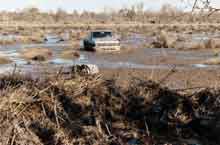You are here: Home › Stressors › Hypoxia & Nutrient Pollution › Extensive Post-Katrina/Rita Sampling Stirs Debate Over Sediment and Management Strategies for Wetland Restoration
Extensive Post-Katrina/Rita Sampling Stirs Debate Over Sediment and Management Strategies for Wetland Restoration
Released October 4, 2006

A National Centers for Coastal Ocean Science (NCCOS)-supported study, funded through the Barataria Multiple Stressor Research Program, estimated that deposition from hurricanes is the dominant process supplying inorganic sediments to Louisiana coastal wetlands. This conclusion suggests that sedimentation from hurricanes should be factored into evaluating the effectiveness of management strategies for restoring Louisiana's wetlands. Using deposition rates derived from an extensive sampling of Louisiana's coastal watersheds shortly after Hurricanes Katrina and Rita, the amount of storm-transported material was estimated to be much greater than that introduced to wetlands via the historical overbank flow, levee breaks, or river diversions. Louisiana's coastal marshes are rapidly disappearing, and Mississippi River diversion is a key management practice for wetland restoration. These results, recently published in Science (22 September 2006: Vol. 313. no. 5794, p. 1713), have generated a significant amount of debate and press coverageómaking it all the way to “News of the Week” on the virtual Science Xpress web site at http://www.sciencemag.org/cgi/content/full/313/5794/1713 . For more information, please contact Alan.Lewitus@noaa.gov.
Related Links

